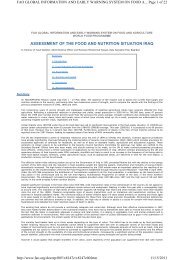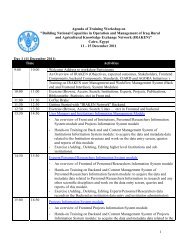Vermiculture in Egypt: - FAO - Regional Office for the Near East and
Vermiculture in Egypt: - FAO - Regional Office for the Near East and
Vermiculture in Egypt: - FAO - Regional Office for the Near East and
Create successful ePaper yourself
Turn your PDF publications into a flip-book with our unique Google optimized e-Paper software.
5.3.2. Vermicompost<strong>in</strong>g of agricultural wastes<br />
Vermicompost<strong>in</strong>g of crop residues <strong>and</strong> cattle shed wastes can not only produce a<br />
value-added product (vermicompost<strong>in</strong>g) but at <strong>the</strong> same time acts as best culture<br />
medium <strong>for</strong> large-scale production of earthworms.<br />
The compost<strong>in</strong>g ability <strong>and</strong> growth per<strong>for</strong>mance of E. eugeniae were evaluated by<br />
us<strong>in</strong>g a variety of comb<strong>in</strong>ations of crop residues <strong>and</strong> cattle dung, under laboratory<br />
conditions. The best results <strong>in</strong> terms of nutrient enhancement <strong>in</strong> <strong>the</strong> end product were<br />
recorded <strong>in</strong> vermicomposted beds as compared to experimental compost<strong>in</strong>g without<br />
worms. Moreover, vermicompost showed higher amounts of total nitrogen, available<br />
phosphorous, exchangeable potassium <strong>and</strong> calcium content. The ready end product<br />
showed relatively lower C:N ratio <strong>and</strong> comparatively was a more stabilized product.<br />
A considerable amount of worm biomass <strong>and</strong> cocoons were produced <strong>in</strong> different<br />
treatments. However, quality of <strong>the</strong> feed stuff, used <strong>in</strong> this study was of a primary<br />
importance, determ<strong>in</strong><strong>in</strong>g <strong>the</strong> earthworm‟s growth parameter, e.g. <strong>in</strong>dividual biomass,<br />
cocoon numbers, growth rate. The results suggest that crop residues can be used as an<br />
efficient culture media <strong>for</strong> large-scale production of E. eugeniae <strong>for</strong> susta<strong>in</strong>able l<strong>and</strong><br />
restoration practices at low-<strong>in</strong>put basis (Suthar, 2008).<br />
5.3.3. Vermicomposts effect on plant growth<br />
It is well established that earthworms have beneficial physical, biological <strong>and</strong><br />
chemical effects on soils <strong>and</strong> can <strong>in</strong>crease plant growth <strong>and</strong> crop yields <strong>in</strong> both natural<br />
<strong>and</strong> managed ecosystems. These beneficial effects have been attributed to<br />
improvements <strong>in</strong> soil properties <strong>and</strong> structure, to greater availability of m<strong>in</strong>eral<br />
nutrients to plants, <strong>and</strong> to biologically active metabolites act<strong>in</strong>g as plant growth<br />
regulators.<br />
Earthworm (Eisenia foetida) compost strongly affects soil fertility by <strong>in</strong>creas<strong>in</strong>g<br />
availability of nutrients, improv<strong>in</strong>g soil structure <strong>and</strong> water hold<strong>in</strong>g capacity. It has<br />
been suggested that earthworms can <strong>in</strong>crease <strong>the</strong> velocity of decomposition of organic<br />
residues <strong>and</strong> also produce several bioactive humic substances. These substances are<br />
endowed with hormone like activity that improves plant nutrition <strong>and</strong> growth. Humic<br />
acids (HAs) comprise one of <strong>the</strong> major fractions of humic substances.<br />
An experiment was conducted to p<strong>in</strong>po<strong>in</strong>t precisely a biological mechanism by which<br />
vermicomposts can <strong>in</strong>fluence plant growth positively <strong>and</strong> produce significant<br />
<strong>in</strong>creases <strong>in</strong> overall plant productivity, <strong>in</strong>dependent of nutrient uptake. Mix<strong>in</strong>g <strong>the</strong><br />
conta<strong>in</strong>er media with <strong>in</strong>creas<strong>in</strong>g concentrations of vermicompost-derived humic acids<br />
<strong>in</strong>creased plant growth, <strong>and</strong> larger concentrations usually reduced growth, <strong>in</strong> a pattern<br />
similar to <strong>the</strong> plant growth responses observed after <strong>in</strong>corporation of vermicomposts<br />
<strong>in</strong>to conta<strong>in</strong>er media with all needed m<strong>in</strong>eral nutrition. Plant growth was <strong>in</strong>creased by<br />
treatments of <strong>the</strong> plants with 50–500 mg/kg humic acids, but decreased significantly<br />
when <strong>the</strong> concentrations of humic acids <strong>in</strong> <strong>the</strong> conta<strong>in</strong>er medium exceeded 500–1000<br />
mg/kg. Although some of <strong>the</strong> growth enhancement by humic acids could have been<br />
partially due to <strong>in</strong>creased rates of nitrogen uptake by <strong>the</strong> plants, most of <strong>the</strong> results<br />
reported exceed those that would result from such a mechanism, very considerably.<br />
However, this does not exclude <strong>the</strong> possibility of o<strong>the</strong>r contributory mechanisms by<br />
50





